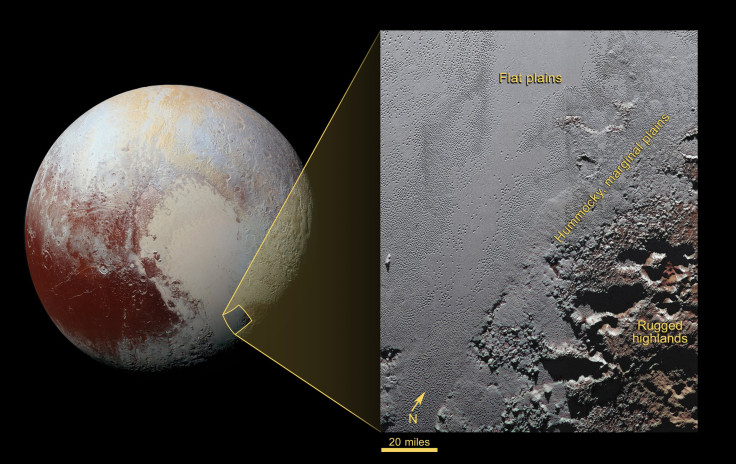New Horizons Image Reveals ‘Krun Macula,’ Pluto’s Rugged And Dark Highlands

It’s been almost a year since the New Horizons spacecraft flew by Pluto, snapping a series of images that has since completely transformed humanity’s understanding of the distant icy world. They have revealed a world filled with complex features far beyond anything we could ever have imagined — a battered surface littered with canyons, mountains and hills of nitrogen ice.
On Thursday, NASA released yet another enhanced color image of Pluto’s surface. The image, created using three separate observations made by New Horizons last July, show the southeastern portion of Pluto’s great ice plains bordering dark highlands informally known as “Krun Macula.”
As the space agency explains in a statement accompanying the image, Krun is the lord of the underworld in the ancient Mandaean religion, and a macula is a dark feature on a planetary surface.
“Krun Macula rises 1.5 miles (2.5 kilometers) above the surrounding plain – informally named Sputnik Planum – and is scarred by clusters of connected, roughly circular pits that typically reach between 5 and 8 miles (8 and 13 kilometers) across, and up to 1.5 miles (2.5 kilometers) deep,” NASA said in the statement. “At the boundary with Sputnik Planum, these pits form deep valleys reaching more than 25 miles (40 kilometers) long, 12.5 miles (20 kilometers) wide and almost 2 miles (3 kilometers) deep – almost twice as deep as the Grand Canyon in Arizona – and have floors covered with nitrogen ice.”
Although scientists believe that these deep pits may have formed when the surface collapsed, what triggered such a collapse is still not clear.
“These data respectively represent portions of the highest- and second-highest-resolution observations obtained by New Horizons in the Pluto system,” NASA said.
New Horizons’ observations of the erstwhile planet have, over the past few months, triggered a flurry of theories about Pluto’s formation, its geology, and that of its moons — Charon, Styx, Nix, Kerberos and Hydra. In March, researchers published five studies, each one providing a detailed analysis of Pluto's landscape, atmosphere, moons, chemistry, and its interaction with solar wind.
© Copyright IBTimes 2024. All rights reserved.






















